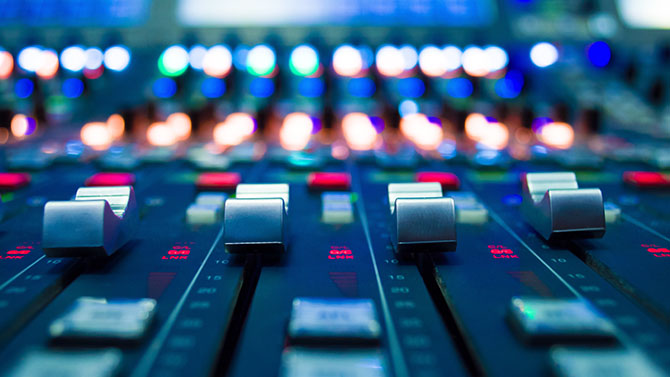Whether buying new or upgrading, here’s what you need to know to make the right purchasing decision.
To paraphrase Henry Ford (who said you could buy any color Model T you wanted, as long as it was black), you used to be able to buy any kind of mixer Definition:
Definition:
Combiner, controller, and router for multiple audio or video signals. you wanted—as long as it was analog Definition:
Definition:
A signal that is continuous in nature, as opposed to being defined as a series of discrete numbers (or elements) as found in digital signals; electrically "analogous" to an acoustical signal in the air.. Today, though, there’s a sometimes bewildering array of options. In additional to analog mixers, you’ll find digital Definition:
Definition:
A signal or data expressed as series of the digits 0 and 1, typically represented by values of a physical quantity such as voltage or magnetic polarization. mixers, hybrid mixers with characteristics of analog and digital mixers, and even mixers that can do double-duty as computer audio interfaces. Let’s start with an overview of each type, and then do a deep dive into the pros, cons, and characteristics of today’s digital mixers.
Analog Mixers have been with us from the beginning of electronic sound recording, broadcast, and entertainment. They use analog solid-state (or formerly, tube Definition:
Definition:
(slang) A vacuum tube or (valve), an electronic amplifying or rectifying element with a heating filament, in a glass or metal envelope.) electronics to combine two or more signals to one or more outputs. The main downside of analog mixers is that they’re difficult to reconfigure, and generally lack the ability to memorize settings. Some people prefer the sound of analog mixers, although that opinion may be based on comparisons to early digital mixers, which lacked the fidelity of today’s models.
Digital Mixers typically have analog inputs and outputs to interface with analog outboard equipment, but they combine, route, and process all audio signals in the digital domain, using computer-based processes. There may also be digital inputs for interfacing with devices that have digital outputs. Some manufacturers use the term “digital” when any “digital” functions are present, but with a truly “digital” mixer, the primary channel Definition:
Definition:
1. In radio, television, citizen's band radio, and other wireless communications modes, a specific frequency for communication. 2. In mixers and video, an input or output signal path with controls. 3. In MIDI, one of 16 data paths. processing, mixing and routing functions are all handled in the digital domain.
USB Definition:
Definition:
(Universal Serial Bus) A standard, bi-directional serial connection between computers and peripheral devices. Mixers come in two basic flavors. Some are conventional analog mixers, with a built-in USB output that can connect to computers, tablets and cell Definition:
Definition:
1. An element of a battery that provides between 1.3 and 2.0 volts each (AAA, AA, C, and D Cells are popular). 2. In mobile communications, an area covered by one of many antennas. phones. More sophisticated models add USB audio interfacing capabilities to true digital mixers. In either case, the goal is a mixer that can do double-duty as a live performance mixer, or in the studio, as a router Definition:
Definition:
1. (computers) A networking device that forwards data packets among different computer networks, such as between the internet and home or enterprise computing systems. It may include additional control functions, such as quality of service or security. 2. (broadcast) An audio/visual switcher (matrix)., mixer, interface, and possibly a control surface Definition:
Definition:
A device that provides mechanical controls, such as switches, rotary controls, and faders to provide hands-on control of software parameters. A typical application is creating a box with faders to control the levels in a software mixer. for DAW Definition:
Definition:
DAW (Digital Audio Workstation): A computer program or stand-alone device that provides digital audio recording, editing, and mixing. functions.
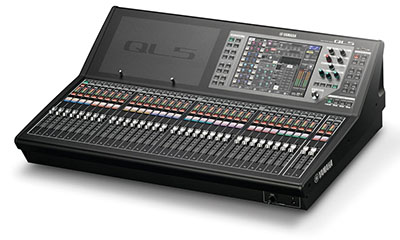
Yamaha QL5
Hybrid Mixers combine analog and digital technology. Their core is an analog mixer, but with some digital functionality—such as a digital output, memory presets, and DSP Definition:
Definition:
1. DSP (Digital Signal Processor): An integrated circuit or device that mathematically alters sound or video signals. 2. DSP (Digital Signal Processing): The technique of converting an analog signal into digital data, manipulating that data, then producing an analog output that reflects the changes caused by these manipulations done in the digital domain. effects like EQ, compression Definition:
Definition:
1. Reducing the dynamic range of an audio or video signal for consistency, to keep it from exceeding the available headroom, or providing a special effect. 2. With data, using a process to reduce the amount of data. Compression can be lossless, where decompressing replicates the original signal, or lossy, where compression occurs by judging some data as unnecessary, and can therefore be discarded from the file., delay, and reverb Definition:
Definition:
Short for Reverberation. The myriad echoes of decaying amplitude created in an acoustic environment. Reverberation may be simulated electronically, mechanically using springs or a metal plate, or in a specially built physical chamber with reflective surfaces where a speaker sends audio into the chamber, and a microphone picks up the reflections..
Analog vs. Digital
Digital mixers are feature-rich, versatile, and offer capabilities that would be impossible with analog hardware—like including a complete channel strip Definition:
Definition:
A combination of preamp and signal processing, similar to the contents of a single channel in a mixer or console., with EQ and dynamics Definition:
Definition:
In a musical performance, changes in overall volume levels, often accompanied by timbral changes. Example: Classical symphonic music has a wide dynamic range, while dance mixes have a much narrower dynamic range., on every mixer channel. However, a digital mixer’s operation is less obvious than analog mixers, because physical inputs and stated channel numbers may not correlate. Also, unlike analog devices where every variable parameter has a physical control, a digital mixer may have multiple virtual controls, which require delving into a menu of options to edit their parameters.
Analog mixers are often a better choice if they will be used by people with different levels of training, because their operation and configuration is more consistent and obvious. However, those who are can follow a bit of a learning curve, and explore the unique differences between digital mixers, can benefit from digital’s cost-effectiveness, versatility, and often, smaller footprint Definition:
Definition:
The amount of desk or floor space taken up by a computer or similar device. for a given amount of functionality.

GB8
Digital Mixer Features
Inputs & Outputs
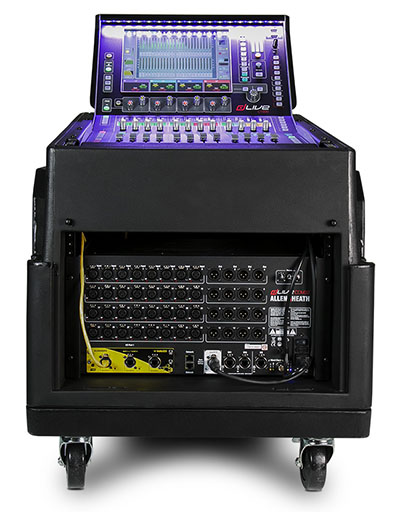
Allen & Heath C1500CDM32 in rack
Because you can expand most digital mixers with networked expansion boxes, the specifications for “inputs” or “channels” can be confusing. The nebulous meaning of “channel” could mean the number of actual or external inputs, but the mixer may be able to mix only a limited number of those inputs to a limited number of outputs at a time. Furthermore, the number of faders on a digital mixer rarely correlates to the number on channels the mixer can actually process, especially for mixers with digital inputs. Finding this information in published specifications isn’t always easy, so please call us for expert clarification. We can help ensure a mixer will meet your specific needs.
External I/O Network
Most digital mixers can have additional inputs and outputs added with external interface boxes and can route onboard and external inputs and outputs to nearly any mixer channel. Standard protocols like Dante Definition:
Definition:
Dante™ (Digital Audio Network Through Ethernet): The audio-over-IP standard created by Audinate (layer 3)., Cobranet Definition:
Definition:
Peak Audio's network standard for transmitting audio, video and control signals., AVB Definition:
Definition:
AVB (Audio Video Bridging): A network standard by the Avnu Alliance., AES Definition:
Definition:
AES (Audio Engineering Society): A professional audio engineering and standards association., and MADI Definition:
Definition:
MADI (Multichannel Audio Digital Interface): Originally called AES10. A unidirectional (sender to receiver), digital audio interface that has common features with the AES3 stereo digital audio interface. MADI transmits up to 64 channels serially over fiber-optic or coaxial lines. allow networking different brands of digital devices, often over the long distances made possible by Ethernet Definition:
Definition:
A local area network (LAN) using cables classified according to certain categories (CAT5, CAT6, CAT5e, etc.). These relate to the speed a cable can handle. connections. For example, the front-of-house mixer, the monitor mixer Definition:
Definition:
An off-stage mixer or an operator of a mixer, whose mixes feed stage monitor speakers, wedges, or IEMs. See Monitor, IEM Wedge. for performers on stage, and a broadcast mixer Definition:
Definition:
A mixer with special features for live broadcast, such as tools to cue up prerecorded or live programming, monitoring of "Program," "Air," and "Audition." can all use different mixers that connect to each other for common monitoring functionality. A stage box Definition:
Definition:
A portable box with connectors for sound, lighting, or power attached to a multiconductor cable (snake) or Cat-5/6 multichannel signal. that containing microphone preamps at the stage can connect to the front of house mixer through Ethernet CAT5/6 cabling, which avoids the need for a bulky, expensive analog “snake.”
Some mixers have proprietary protocols that work with only that brand’s peripheral devices, while some mixers have Option Card Slots for additional standards. The external I/O Definition:
Definition:
(Input/Output): 1. A pair of connections that provide input(s) and output(s). 2. The connections that link a computer to devices outside the computer. can take the form of stage boxes, rack Definition:
Definition:
A frame for holding gear that meets an industry standard for enclosures. This specifies a 19 inch width, and a height that is some multiple of 1.75 inches. A rack frame can be open or enclosed, and has rails drilled with standardized screw holes for attaching rack equipment.. interfaces, and various other devices that speak the same network protocols.
Advantages of Network Connectivity
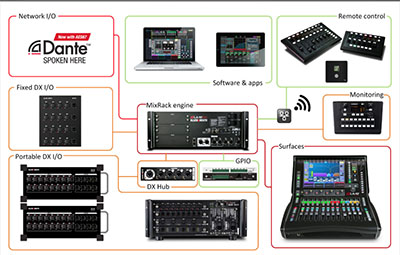
Sample system diagram
With analog connections, connecting various audio devices within a facility and between facilities creates well-known challenges. Analog signal paths can lose quality when sent any significant distance, and pick up noise, crosstalk Definition:
Definition:
An undesired audio signal that originates from adjacent wires or adjacent channels., and hum Definition:
Definition:
An undesired continuous signal caused by AC electrical power, typically 60/50 Hz and its harmonics. from other lines and adjacent power systems. Hum caused by ground loops is also an issue in any medium-to-complex system, and tracking Definition:
Definition:
1. Recording or overdubbing audio tracks. 2. Sensing the position of a person, a person's head, or camera position for Augmented and Virtual Reality purposes as well as motion tracking. down the source requires troubleshooting and experimentation.
On the other hand, digital systems are inherently immune to noise, hum, and other low-level audio artifacts Definition:
Definition:
Errors in digital conversion, recording, processing or transmission of audio and visual information caused by compression, quantization, jitter and/or packet loss. because they carry data—not audio. Digital systems can travel long distances with no deterioration in quality. Most of the network protocols for digital audio systems operate over standard CAT5/6 IP Definition:
Definition:
1. IP (Internet Protocol): A digital data standard over Ethernet. 2. IP (Ingress Protection): A rating of an electrical device, such as a lighting fixture, regarding protection from foreign objects or water. 3. IP (Intellectual Property): Refers to creations of the mind, such as inventions; literary and artistic works; designs; and symbols, names and images used in commerce. Intellectual Property is protected in law by, for example, patents, copyright and trademarks, etc. network cabling and employ high-quality network switches; this infrastructure may already be in your facility. Digital routing can be done either with CAT5/6 patchbays, or in configurable software. Installed digital systems can also be controlled, configured, and monitored from remote Definition:
Definition:
A broadcast from the field, not from the studio. A Remote Control. locations with web browsers. These are often compatible Definition:
Definition:
Capable of operating with a particular selection of hardware or software. with mobile devices, as well as fixed installations based on desktop computers. Furthermore, subnets allow isolating different groups of networked audio equipment.
Presets and Cues
Digital mixers can memorize most of their parameters such as levels, EQ, effects, and routing, and then organize them into a series of cues/scenes to follow stages of a performance, or settings for different shows at different times. Most can offload the cues to a thumb drive or the cloud for future use. Unfortunately, presets are almost always not compatible among brands, or even for different series within some brands. For recording and post-production video, cues/changes are saved in the editing program, not in the mixer.
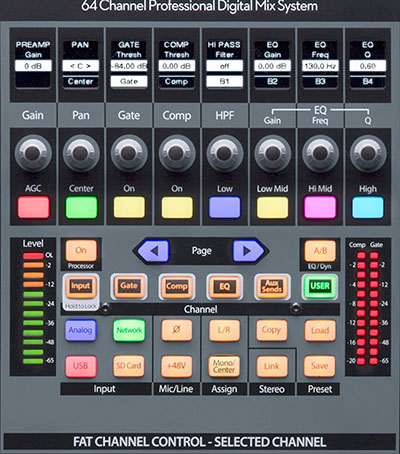
PreSonus Fat Channel
Control Panel Simplification
An analog console’s sea of controls for each parameter on can be condensed to one set of controls or touch screens on a digital mixer. For example, the PreSonus StudioLive mixers have a single “Fat Channel” interface (with EQ, compression, limiting, high-pass filter Definition:
Definition:
A circuit or sometimes, mechanical device that passes audio above a specific frequency, and attenuates audio below that frequency. A typical audio application is reducing frequency response below 50-200 Hz to minimize hum, room noise, plosives, and bass reflection build-ups due to acoustical issues. , etc.), but it can be programmed to process any channel. In an analog console Definition:
Definition:
A control surface for audio, video, or lighting control positioned like a desk. Also called, Mixer, Controller, Board, or (British) Desk., having this many controls for each channel would have knobs and switches stretching as far as the eye can see—but with digital, you choose the channel you want to process, then edit it with a single set of controls.

Digital: SIperformer (left), Analog: GB4Input (right)
With many mixer designs, channels can be in “layers” that represent many more input channels than the faders on the console. For example, 8 faders might control channels 1 through 8, but switching to different layers would allow them to control channels 9-16, or 17-24. One of these layers might even be able to serve as a control surface for a DAW’s virtual mixer. Some digital mixers can even be reconfigured for different uses such as sound reinforcement Definition:
Definition:
Originally meant to electrically augment acoustic performances, but now means any public address system. See PA., recording, post-production, or broadcast.
Other functionality includes being able to gang controls—like ganging together all the faders that affect individual drum levels, so moving one fader Definition:
Definition:
An audio control, rotary or linear, to control volume level. moves them all. Being able to copy and paste channel parameters is another time-saver. This is especially true with presets, because you can copy a preset Definition:
Definition:
1. (verb) Ability to set parameters in advance, and recall those parameter values as desired. 2. (noun) A collection of parameter values stored within a device, or externally. and paste it into a channel.
Controls
Analog mixer controls are finite—sliders and rotary controls have limited travel (from none to maximum), and buttons click on or off. Digital mixers have some controls like analog mixers, but finite controls cannot recall presets. Motorized faders, and high-resolution Definition:
Definition:
1. (video) The measure of pixels horizontally and vertically. For example, 1920x1080 is considered HD, or high-definition. 2. (audio) The combined bit depth and sample rate of a digital audio signal. endless rotary encoder Definition:
Definition:
A device that converts shaft rotation into digital data. An absolute type outputs the absolute position, while an incremental type outputs changes in position. knobs, make preset storage and recall possible. Soft-Keys are buttons that can represent most anything or activate a preset. There may even be a “shift” button that assigns an entirely different set of functions to buttons or faders.
Fortunately, most digital mixers have LCD Definition:
Definition:
LCD (Liquid Crystal Display): A display that uses fluid crystals that can block, reflect, or transmit light from a back illuminator, and uses very little power. screens that can display various functions so you can stay oriented to the task at hand, and may even be able to show EQ curves, dynamics processing characteristics, preset libraries, routing and more.
Remote Control
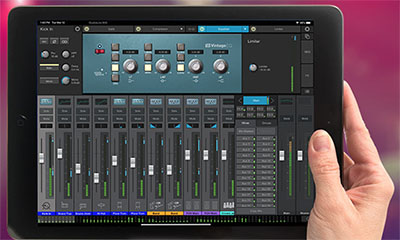
Tablet Control
Digital mixers can be controlled in a variety of ways: solely from the front panel, over a network, via USB, using MIDI Definition:
Definition:
(Musical Instrument Digital Interface) A hardware/software standard for communication of musical data digitally among electronic instruments, effects, and computers. However it is also used for to control lighting, pyrotechnics, theatrical displays, and mechanical devices. For example, the fountains at the Bellagio in Las Vegas is controlled by MIDI. Also called MIDI 1.0., or wirelessly. These controllers can physically duplicate mixer functions using wireless tablets, smartphones, or standard computers. This can be useful if the mixer isn’t located in a venue’s “sweet spot,” because during setup, the operator can wander around a venue, and hear the system at various locations and be in control. Wireless control also allows for unique functions, like letting performers dial in their own monitor mix for in-ear monitors.
Indicators & Meters
Most mixers have a limited number of LED Definition:
Definition:
LED (Light-Emitting Diode): A semiconductor light generator used in displays, television, pointers and for general illumination. It is a low-power replacement for incandescent lamps. bar-graph meters for master outputs or solo levels. Many mixers also have meters on individual input channels. Flashing LEDs or the display screen can indicate which channel is currently being controlled by a particular user interface (e.g., like the Fat Channel mentioned previously). Some mixers have LCDs for individual channels that can be programmed to display the channel name (also called a Scribble Strip), and may even have a video output to display settings on a larger computer monitor.
Digital Signal Processors
Digital mixers have onboard DSP (Digital Signal Processing) which not only mix and route audio, but often include signal processing Definition:
Definition:
Alteration of sound or video signals by using a hardware device or software. Typical signal processing devices include equalization, compression, reverb, color correction, blur, glow, etc. like reverberation, delay, EQ, compression, limiting, gating, and feedback suppression. Not having to carry around a rack full of analog signal processors is enough of a reason for many people to upgrade to an all-digital mixer. These effects may be available on input and output channels and sub-routing buses. There may even be a click track Definition:
Definition:
1. A metronome track to assist a musician's timing during live performance or recording. 2. An audio track to which some rhythmically oriented devices can synchronize. or metronome that goes only to a performer’s in-ear monitor, so those on stage can play to a common timing signal. Higher-end mixers can also include diagnostic tools like oscillators, spectrum analyzers, and global EQs tied to real-time analysis.
Playback
What to do when the headliner is late is an age-old question, but now we have an answer. Mixers often include a way to play back music, announcements, or backing tracks. Some have enough memory to load pre-recorded material or can play back audio from a USB thumb drive connected to a USB port.
Recording
All mixers can be used for recording with external recorders, but digital mixers often have built-in functions for direct out Definition:
Definition:
1. A feature on some mixers that taps the signal from a specific channel, and bypasses the mix bus. 2. A signal processor output that carries the dry (unprocessed) signal prior to going into the processor., stereo Definition:
Definition:
A two channel signal simulating a sound space, typically played through two speakers. and multitrack Definition:
Definition:
A recorder that can record more than one individual track at a time, or individual tracks in sequence for subsequent mixing. recording, either to internal or external memory. Most have digital outputs (S/PDIF Definition:
Definition:
(Sony/Philips Digital Interconnect Format) A protocol for a stereo digital audio connection, based on AES3, that uses coaxial cable or TOSlink optical cables., USB, AES/EBU Definition:
Definition:
AES/EBU (Audio Engineering Society/European Broadcasting Union): A 2-channel digital audio format created by the AES and EBU that uses XLR connectors, and is similar to the S/PDIF digital audio format., Thunderbolt Definition:
Definition:
A computer interface port or cable that multiplexes PCIe and DisplayPort data lines into two serial signals (along with DC power), which is then demultiplexed into separate PCIe and DisplayPort ports by the Thunderbolt controllers at receiving devices., FireWire Definition:
Definition:
Apple protocol (also IEEE-1394), developed with other companies including Sony and Panasonic, for digital data transfer at rates of 100-800 Mbps or network/IP). Recording studio-specific functions, such as separate control room and studio playback, talkback Definition:
Definition:
A communication system between rooms, typically control room and studio. and slate, may not be present on mixers designed primarily for reinforcement.
Although most digital mixers are configured for sound reinforcement, some are equally at home in the studio. They may even be able to act as an interface and controller Definition:
Definition:
1. A MIDI device (keyboard, guitar with appropriate interface, etc.) that alters parameters in a synthesizer or other MIDI sound generator. 2. A device (e.g., modulation wheel, pitch bender, ribbon controller, etc.) that varies some specific parameter in a synthesizer or other MIDI sound generator. for the virtual mixers in DAWs. So, you can use the mixer while tracking to send multiple inputs into your DAW, and then as a hands-on control surface when mixing, instead of being limited to on-screen, virtual controls.
Microphone Preamps
Most digital mixers’ preamp gain is controllable, just as any other digital function is controlled. This allows for far more precise, repeatable settings compared to staring at a knob and hoping you’ve set it to the right position. For FOH Definition:
Definition:
FOH (Front of House): Typically a sound mixing or lighting control position. (Front of House) applications, most of the preamps are located remotely in stage boxes. This avoids having to run low-level signals back to a mixer, which would subject them to a loss of audio quality. Also, networking allows input preamps to be shared by two or more consoles.
Note that when preamps are shared by two consoles (such as in a FOH/monitor-mix configuration or a FOH/recording setup), some models can scale/compensate the channel gain in the mixers, since changing preamp gain by one operator will change the channel level at the other mixer.
Self-Contained vs. Separate Control Surface and Mix Engine
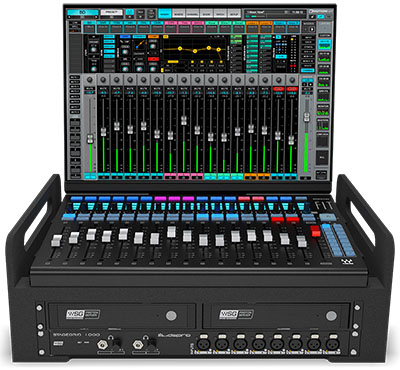
Waves LV1, controller, Computer and Server
Most traditional analog mixers were self-contained since controls are attached directly to the audio circuits. In a digital mixer, the controls work more like the way a computer keyboard and mouse connect to a computer. The audio in a digital mixer is processed essentially by a computer, so it doesn’t need to be in the same housing as the control surface. Many digital mixers are self-contained, but some are in the form of “rack mixers,” “mix engines,” or “servers” and can be controlled locally or remotely by traditional control surfaces, from tablets, computers via USB, wirelessly, or from a network.
Controllers are usually made by the same company that makes the mix-engine, but there are universal controllers or HUI’s (Human User Interfaces) that may be compatible but need more configuration than “purpose-built” controllers. Most higher-priced systems are split between controller and engine. At the low end of the scale there are also “rackmount/stage-box” mixers with minimal or no controls onboard, but depend on the kind of external controllers mentioned above. Most of the rack mixers and some of the higher-end mixer engines have onboard analog inputs and outputs.
Quality of Sound
The nature of digital mixers is that, when used and gain-staged properly, they are naturally very low in distortion Definition:
Definition:
A change in an electronic or acoustic signal's waveform. This can undesirable if it impacts signal quality, or desirable when used for creative signal processing. and noise. Any limitations involve the bit resolution and sampling rate used to get analog signals into the mixer through analog-to-digital conversion, and send the mixed analog audio out of the mixer using digital-to-analog conversion. But gain-staging is crucial—overloading any portion of the signal path through any mixer, digital or analog, will create nasty distortion. On the other hand, too low a signal level can impose noise and quantization errors (i.e., where the full resolution of a digital system isn’t used). Mixers designed primarily for recording have their gain structure Definition:
Definition:
Multiple interconnected components and their relative gain or operating level, which work together to maximize headroom and minimize noise. optimized for lowest noise and distortion, whereas mixers designed for live sound reinforcement are configured to minimize the chance of overload Definition:
Definition:
Causing a device to exceed its capability, usually undesirable but used for an "overdrive" effect in music. Also called 'Blooming" in classic recordings. See Overdrive. at the expense of some noise or distortion, which is not audible in live venues. Make sure you purchase any mixer based on its primary use.
Reliability, Service and Cost
Like most everything in life, you usually get what you pay for. Another adage is that the relationship between quality and cost is not linear since mass-produced systems are less expensive per unit to manufacture. A lot depends on the need for reliability and support. Between the dealer and manufacturer, what kind of support is available in case of a failure, and how critical is that support? Higher-priced systems have a more robust support network, and the devices are better built (as well as easier to repair) if failures happen.
Failures in digital systems are different from analog systems. Analog mixer failures are usually located in a particular channel, and rarely take the whole system down unless the failure relates to the power supply Definition:
Definition:
A device (internal or external to another device) that provides power for active circuitry. Can be AC, DC or battery-powered. (mixers with an external power supply have an advantage in that respect). Users can make do with a missing channel. This kind of failure can also happen in the analog portions of a digital mixer, but failure of the internal digital engine is usually an all-or-nothing proposition, as in total failure. Mass produced system are unlikely to be repairable in the field, while more expensive systems use modular construction methods that allow field swaps of complex circuitry.
The Bottom Line
Analog mixers are proven, fast, and have an obvious workflow. Digital mixers have more of a learning curve, but what you get in return is more power and amazing flexibility. Digital mixers have gone from a curiosity to a mainstay of modern live performance and recording. There’s a reason why many sound mixers and engineers have decided to make the move to digital, just as there’s a reason why some prefer to stay with analog.
Fortunately, there are so many mixer options there’s almost certainly one that will fit your exact needs. The key is being able to define your needs, and then match them with the right mixer. That’s where the experts at Full Compass can help. Once we know what you need to do, we can identify the mixer that will best suit your needs, configure Definition:
Definition:
1. To alter the way in which software interacts with a computer system in order to make the software compatible with a specific set of peripherals. 2. To alter parameters in a system's hardware elements so that they can work together in a system context. it for your particular application, and stay within your budget.
Resources
Full Compass’s GearCast site offers a wide range of articles and videos that relate to both analog and digital mixers. They’ll help you get up to speed on the latest developments in mixers, as well as provide background on mixers in general.
By Jonathan Lipp, Founder Full Compass Systems



